[English] 日本語
 Yorodumi
Yorodumi- PDB-6s85: Cutting state of the E. coli Mre11-Rad50 (SbcCD) head complex bou... -
+ Open data
Open data
- Basic information
Basic information
| Entry | Database: PDB / ID: 6s85 | |||||||||
|---|---|---|---|---|---|---|---|---|---|---|
| Title | Cutting state of the E. coli Mre11-Rad50 (SbcCD) head complex bound to ADP and dsDNA. | |||||||||
 Components Components |
| |||||||||
 Keywords Keywords | DNA BINDING PROTEIN / Nuclease / DNA repair / ABC-type ATPase / DNA double-strand breaks | |||||||||
| Function / homology |  Function and homology information Function and homology informationdouble-stranded DNA endonuclease activity / DNA replication termination / DNA exonuclease activity / single-stranded DNA endodeoxyribonuclease activity / 3'-5'-DNA exonuclease activity / DNA repair complex / exonuclease activity / 3'-5' exonuclease activity / double-strand break repair / endonuclease activity ...double-stranded DNA endonuclease activity / DNA replication termination / DNA exonuclease activity / single-stranded DNA endodeoxyribonuclease activity / 3'-5'-DNA exonuclease activity / DNA repair complex / exonuclease activity / 3'-5' exonuclease activity / double-strand break repair / endonuclease activity / DNA recombination / DNA replication / DNA repair / ATP hydrolysis activity / DNA binding / ATP binding Similarity search - Function | |||||||||
| Biological species |  synthetic construct (others) | |||||||||
| Method | ELECTRON MICROSCOPY / single particle reconstruction / cryo EM / Resolution: 4.2 Å | |||||||||
 Authors Authors | Kaeshammer, L. / Saathoff, J.H. / Gut, F. / Bartho, J. / Alt, A. / Kessler, B. / Lammens, K. / Hopfner, K.P. | |||||||||
| Funding support |  Germany, 2items Germany, 2items
| |||||||||
 Citation Citation |  Journal: Mol Cell / Year: 2019 Journal: Mol Cell / Year: 2019Title: Mechanism of DNA End Sensing and Processing by the Mre11-Rad50 Complex. Authors: Lisa Käshammer / Jan-Hinnerk Saathoff / Katja Lammens / Fabian Gut / Joseph Bartho / Aaron Alt / Brigitte Kessler / Karl-Peter Hopfner /  Abstract: DNA double-strand breaks (DSBs) threaten genome stability throughout life and are linked to tumorigenesis in humans. To initiate DSB repair by end joining or homologous recombination, the Mre11- ...DNA double-strand breaks (DSBs) threaten genome stability throughout life and are linked to tumorigenesis in humans. To initiate DSB repair by end joining or homologous recombination, the Mre11-nuclease Rad50-ATPase complex detects and processes diverse and obstructed DNA ends, but a structural mechanism is still lacking. Here we report cryo-EM structures of the E. coli Mre11-Rad50 homolog SbcCD in resting and DNA-bound cutting states. In the resting state, Mre11's nuclease is blocked by ATP-Rad50, and the Rad50 coiled coils appear flexible. Upon DNA binding, the two coiled coils zip up into a rod and, together with the Rad50 nucleotide-binding domains, form a clamp around dsDNA. Mre11 moves to the side of Rad50, binds the DNA end, and assembles a DNA cutting channel for the nuclease reactions. The structures reveal how Mre11-Rad50 can detect and process diverse DNA ends and uncover a clamping and gating function for the coiled coils. | |||||||||
| History |
|
- Structure visualization
Structure visualization
| Movie |
 Movie viewer Movie viewer |
|---|---|
| Structure viewer | Molecule:  Molmil Molmil Jmol/JSmol Jmol/JSmol |
- Downloads & links
Downloads & links
- Download
Download
| PDBx/mmCIF format |  6s85.cif.gz 6s85.cif.gz | 367.7 KB | Display |  PDBx/mmCIF format PDBx/mmCIF format |
|---|---|---|---|---|
| PDB format |  pdb6s85.ent.gz pdb6s85.ent.gz | 269.9 KB | Display |  PDB format PDB format |
| PDBx/mmJSON format |  6s85.json.gz 6s85.json.gz | Tree view |  PDBx/mmJSON format PDBx/mmJSON format | |
| Others |  Other downloads Other downloads |
-Validation report
| Summary document |  6s85_validation.pdf.gz 6s85_validation.pdf.gz | 1 MB | Display |  wwPDB validaton report wwPDB validaton report |
|---|---|---|---|---|
| Full document |  6s85_full_validation.pdf.gz 6s85_full_validation.pdf.gz | 1.1 MB | Display | |
| Data in XML |  6s85_validation.xml.gz 6s85_validation.xml.gz | 50 KB | Display | |
| Data in CIF |  6s85_validation.cif.gz 6s85_validation.cif.gz | 74.8 KB | Display | |
| Arichive directory |  https://data.pdbj.org/pub/pdb/validation_reports/s8/6s85 https://data.pdbj.org/pub/pdb/validation_reports/s8/6s85 ftp://data.pdbj.org/pub/pdb/validation_reports/s8/6s85 ftp://data.pdbj.org/pub/pdb/validation_reports/s8/6s85 | HTTPS FTP |
-Related structure data
| Related structure data |  10116MC  6s6vC M: map data used to model this data C: citing same article ( |
|---|---|
| Similar structure data |
- Links
Links
- Assembly
Assembly
| Deposited unit | 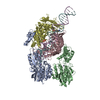
|
|---|---|
| 1 |
|
- Components
Components
-Nuclease SbcCD subunit ... , 2 types, 4 molecules CDAB
| #1: Protein | Mass: 118851.508 Da / Num. of mol.: 2 Source method: isolated from a genetically manipulated source Source: (gene. exp.)  Gene: sbcC, A9R57_08510, ACU57_12010, AM464_18965, AUQ13_18525, BANRA_02011, BANRA_03598, BHS87_02160, BJJ90_20275, BUE81_15555, BW690_06605, C4J69_09480, C5N07_12770, C9E25_04550, CA593_01155, D0X26_ ...Gene: sbcC, A9R57_08510, ACU57_12010, AM464_18965, AUQ13_18525, BANRA_02011, BANRA_03598, BHS87_02160, BJJ90_20275, BUE81_15555, BW690_06605, C4J69_09480, C5N07_12770, C9E25_04550, CA593_01155, D0X26_07450, D3821_12870, D3Y67_14380, D9D20_11475, D9F57_05650, DNQ41_05895, EAI52_02975, EC3426_01234, EL75_3354, EL79_3449, EL80_3403, ERS085365_01836, ERS085416_01964, ERS139211_01256, ERS150873_01854, NCTC13462_01932, NCTC9037_03952, RK56_026675, SAMEA3446340_01460, SAMEA3472047_02107, SAMEA3484427_03539, SAMEA3484429_01893, SAMEA3752559_02893, SAMEA3753300_00462, SK85_00422 Production host:  #2: Protein | Mass: 45599.227 Da / Num. of mol.: 2 Source method: isolated from a genetically manipulated source Source: (gene. exp.)  Gene: sbcD, A9R57_08515, ACU90_20930, AM270_02320, AM464_18970, AMK83_08850, AML07_05375, APZ14_19360, ARC77_21640, AU473_24540, AUQ13_18520, AUS26_08295, AW106_10255, AWF80_027335, B1K96_09895, ...Gene: sbcD, A9R57_08515, ACU90_20930, AM270_02320, AM464_18970, AMK83_08850, AML07_05375, APZ14_19360, ARC77_21640, AU473_24540, AUQ13_18520, AUS26_08295, AW106_10255, AWF80_027335, B1K96_09895, BANRA_00933, BANRA_02010, BANRA_03599, BB545_15570, BHS81_02440, BHS87_02165, BJJ90_20270, BK292_14605, BMT53_08385, BMT91_05280, BN17_02021, BTQ04_02895, BTQ06_17755, BUE81_15560, BVL39_00845, BW690_06610, BWP17_02185, C2U48_08075, C4J69_09475, C5N07_12775, C5P01_16270, C5P43_02310, C6986_02395, C7235_18845, C7B08_06215, C9E25_04545, CA593_01150, CG691_03340, CG705_03245, CG706_02645, COD30_16020, COD46_04825, CR538_19460, CRE06_07850, CVH05_20670, CWS33_22910, D0X26_07455, D2184_11480, D3821_12865, D3822_22430, D3O91_15270, D3Y67_14385, D4M06_05505, D7K63_09095, D7K66_05465, D9H94_07055, D9I87_03345, D9I97_02300, D9J44_05860, D9L89_06325, D9X97_05375, DIV22_26320, DL455_04405, DL545_19095, DL800_03920, DMI04_05300, DMZ31_02500, DNB37_05400, DNQ41_05900, DOY56_05885, DQF57_07710, DQO13_05535, DS732_06955, DTL43_07380, E2855_00535, E2863_00431, EAI44_12705, EAI52_02980, EB509_06820, EB510_01660, EB515_09310, EC1094V2_3455, EC3234A_4c00670, EC3426_01235, EC95NR1_04617, ECs0448, ED225_07565, ED287_10145, ED600_06285, ED607_18305, ED611_06615, ED903_13690, ED944_09545, EEA45_02820, EEP23_01080, EF173_10600, EFV01_15655, EFV11_06690, EFV17_08300, EIA13_09680, EL75_3353, EL79_3448, EL80_3402, ERS085365_01835, ERS085379_01210, ERS085416_01963, ERS139211_01257, ERS150873_01853, ERS150876_00572, FORC28_4694, HW43_05600, NCTC10090_01877, NCTC10429_03756, NCTC11022_05144, NCTC13125_01885, NCTC13127_05149, NCTC13462_01931, NCTC8009_07006, NCTC8179_01650, NCTC8960_01309, NCTC9036_03833, NCTC9037_03951, NCTC9045_04425, NCTC9055_00697, NCTC9058_03126, NCTC9062_04472, NCTC9111_03972, NCTC9703_03216, NCTC9706_01107, PU06_02925, RG28_02875, RK56_026670, RX35_02069, SAMEA3446340_01461, SAMEA3472043_02687, SAMEA3472044_00460, SAMEA3472047_02108, SAMEA3472055_02158, SAMEA3472070_02276, SAMEA3472114_01252, SAMEA3484427_03538, SAMEA3484429_01894, SAMEA3752553_00281, SAMEA3752559_02892, SAMEA3753064_01241, SAMEA3753097_00507, SAMEA3753290_01730, SAMEA3753300_00463, SK85_00423, WR15_04330 Production host:  |
|---|
-DNA chain , 2 types, 2 molecules EF
| #3: DNA chain | Mass: 18518.891 Da / Num. of mol.: 1 / Source method: obtained synthetically / Source: (synth.) synthetic construct (others) |
|---|---|
| #4: DNA chain | Mass: 18464.807 Da / Num. of mol.: 1 / Source method: obtained synthetically / Source: (synth.) synthetic construct (others) |
-Non-polymers , 3 types, 8 molecules 




| #5: Chemical | | #6: Chemical | #7: Chemical | ChemComp-MN / |
|---|
-Details
| Has ligand of interest | N |
|---|
-Experimental details
-Experiment
| Experiment | Method: ELECTRON MICROSCOPY |
|---|---|
| EM experiment | Aggregation state: PARTICLE / 3D reconstruction method: single particle reconstruction |
- Sample preparation
Sample preparation
| Component |
| ||||||||||||||||||||||||
|---|---|---|---|---|---|---|---|---|---|---|---|---|---|---|---|---|---|---|---|---|---|---|---|---|---|
| Molecular weight | Experimental value: NO | ||||||||||||||||||||||||
| Source (natural) |
| ||||||||||||||||||||||||
| Source (recombinant) |
| ||||||||||||||||||||||||
| Buffer solution | pH: 7.5 | ||||||||||||||||||||||||
| Specimen | Embedding applied: NO / Shadowing applied: NO / Staining applied: NO / Vitrification applied: YES | ||||||||||||||||||||||||
| Specimen support | Grid material: COPPER / Grid type: Quantifoil R2/1 | ||||||||||||||||||||||||
| Vitrification | Instrument: FEI VITROBOT MARK IV / Cryogen name: ETHANE / Humidity: 95 % / Chamber temperature: 277 K |
- Electron microscopy imaging
Electron microscopy imaging
| Experimental equipment |  Model: Titan Krios / Image courtesy: FEI Company |
|---|---|
| Microscopy | Model: FEI TITAN KRIOS |
| Electron gun | Electron source:  FIELD EMISSION GUN / Accelerating voltage: 300 kV / Illumination mode: FLOOD BEAM FIELD EMISSION GUN / Accelerating voltage: 300 kV / Illumination mode: FLOOD BEAM |
| Electron lens | Mode: BRIGHT FIELD |
| Image recording | Electron dose: 73.6 e/Å2 / Detector mode: COUNTING / Film or detector model: GATAN K2 SUMMIT (4k x 4k) / Num. of grids imaged: 2 / Num. of real images: 12811 |
| Image scans | Movie frames/image: 25 |
- Processing
Processing
| CTF correction | Type: PHASE FLIPPING AND AMPLITUDE CORRECTION | ||||||
|---|---|---|---|---|---|---|---|
| 3D reconstruction | Resolution: 4.2 Å / Resolution method: FSC 0.143 CUT-OFF / Num. of particles: 152271 / Symmetry type: POINT | ||||||
| Atomic model building | 3D fitting-ID: 1 / Accession code: 4M0V / Initial refinement model-ID: 1 / PDB-ID: 4M0V / Source name: PDB / Type: experimental model
|
 Movie
Movie Controller
Controller





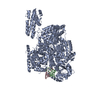


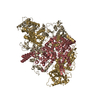
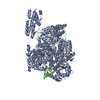
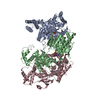
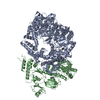
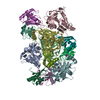
 PDBj
PDBj











































